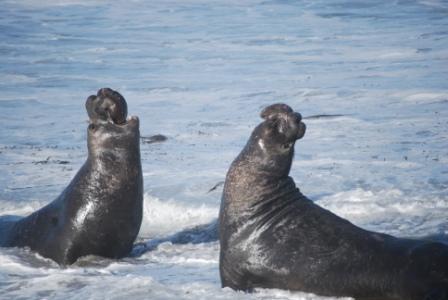
Dominant male elephant seal warns approaching male
I just learned about some fascinating elephant seal history that is a must share. It turns out that the two male elephant seals going head to head in the photo are truly lucky to be alive. In fact all northern elephant seals are lucky to be alive for reasons that are both predictable and shocking.
The predictable reason for the near extinction of elephant seals is of course hunting, also referred to as sealing. According to this great book titled Elephant Seals Population Ecology, Behavior, and Physiology edited by Burney Le Boeuf and Richard Laws, northern elephant seals aka Mirounga angustirostris were thought to be extinct by 1892. Yes, that early!
Elephant seals were hunted extensively for their blubber oil, which was used to light lamps back in the day before electricity. And elephant seal hunters did their best to make sure every elephant seal died for the cause. Here’s a quote from the book: “Because all elephant seals were killed as they were encountered, the species was considered extinct by the late 1870s. But in 1880, a small herd was discovered on the Baja California mainland south of Isla Cedros, at Bahia San Cristobal. Over the next four years, all 335 seals that were seen were killed by the crews of six ships that visited the beach regularly, mostly in autumn. Three years later, in 1883 80 elephants seals were found and killed at Isla de Guadalupe, and 4 were killed there in 1884.” (pages 30-31)
Do you see the pattern here? Every time elephant seals were thought to be extinct, then more were found and killed. After the four were killed in 1884, elephants seals were considered extinct again until nine were discovered again on the Isla de Guadalupe. But here’s the best part of the story and another direct quote from the book: “Seven of them were killed for the Smithsonian’s museum collection.” (page 31) What?!
Then the book quotes A. W. Anthony, someone who seems to be affiliated with the Smithsonian at the time: “This action was considered justified at the time, as the species was considered doomed to extinction by way of the sealer’s trypot and few if any specimens were to be found in the museums of North America.” (pages 31 to 32)
But wait it gets better, I’m just going to quote the book again because it says it all. “The species was presumed to be extinct, for the third time. But small numbers continued to show up at Isla de Guadalupe through 1911, and museum collectors continued to kill them: 4 in 1904 and 14 of 40 on May 26, 1907. ‘This was a severe stroke dealt to a struggling species, but the appetite of science must be satisfied.'” (page 32) Some guy with the last name of Huey said that last priceless bit. In the name of science? Please.
Then C. H. Townsend, another guy associated with the Smithsonian, went back to Isla de Guadalupe in 1911 and killed 10 elephant seals, but left 125 alive. How generous of him.
Despite everyone’s best efforts to kill elephant seals, they are still here today. A true miracle! (Thanks to Bernardo and Diane Alps for tipping me off to this fascinating and disturbing bit of history.)
what pages are the quotes from
Thanks for your comment ofa, I just added page numbers to the post.